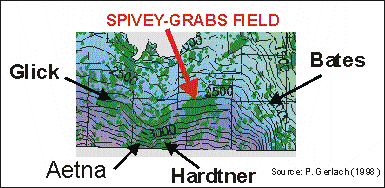
|
Characterization of Mississippian Osage Chat in South-Central
Kansas
|

Kansas Geological Survey
Open-file Report 2002-50 |
Rock Petrophysics
Lithofacies and Petrofacies
Spivey-Grabs Field
Core and Petrophysical Analysis of Miss. “Chat”
General Atlantic Tjaden #A-1 WIW #1
ne sw sw Section 24, T30S, R8W
Kingman County, Kansas |
 |
While the Mississippian chat reservoirs of south-central Kansas
reflect a specific depositional and diagenetic history, the lithofacies
present, the nature of chert formation and dissolution and fracturing,
and the log and core petrophysical properties are likely to be
representative of other shallow shelf chert systems or may shed
light on controls in these systems. The most productive and economic
chat reservoir is a tripolitic chert exhibiting variable degrees
of sponge spicule mold content, chert microporosity, dissolution
vuggy porosity, autoclastic brecciation, and clay infill of fractures.
A core described below from the General Atlantic Tjaden 1-A
WIW contains a succession of four stacked shallowing-upward cycles
in which a complete cycle comprises beds dominated by the following
lithofacies from bottom to top: 1) argillaceous dolomite mudstone;
2) argillaceous dolomite mudstone with chert nodules; 3) clean
dolomite mudstone with nodular chert; 4) nodular to bedded chert;
5) autoclastic chert; 6) autoclastic chert with clay infill; and
7) bioclastic crinoidal wackestone to grainstone.
Lithofacies of Chat reservoirs in south-central
Kansas.
- Chert conglomerate (overlying the chat) conglomerate consisting
of dense and highly porous chert clasts in matrix of clay, quartz
silt, and smaller chert particles; corresponds to Type 3 chat
defined by Montgomery et al. (1998).
- Autoclastic chert with clay infill brecciated insitu highly
porous tripolitic chert with dessication fractures in which clay
has infilled; birefringent clay cutans, grumulous and clotted
fabric, shelter porosity and circum-clast fractures, silicified
sponge spicules or sponge spicule molds varying in concentration
from abundant felted masses to wackestone, variable vuggy porosity
resulting both from dissolution of spicules, bioclasts and matrix,
solution enhanced porosity along fractures, scattered isolated
sucrosic dolomite
- Autoclastic chert brecciated insitu chert with the above
characteristics except fractures and microcracks contain no infilling
clay, corresponding to Type 2 chat defined by Montgomery et al.
(1998).
- Nodular to bedded chert tripolitic chert with massive mottled
appearance to nodular that appear overpacked and fitted, no significant
vuggy porosity content, variable amounts of sponge spicule molds,
mottled areas with more micritic carbonate.
- Cherty dolomite mudstone light gray dolomite mudstone with
variable large (up to 10 cm), white microporous chert nodules,
no distinct bedding
- Argillaceous cherty dolomite mudstone similar to cherty
dolomite mudstone, but with increased argillaceous content and
thin wispy horizontal bedding.
- Sucrosic dolomite massive, medium grained sucrosic dolomite
with porosity between 10-20%.
- Bioclastic crinoidal wacke-grainstone limestone with abundant
crinoids and occasional bryozoans and other bioclasts, generally
tightly cemented with calcite, patchy chalcedony and drusy quartz
cement and replacement of calcite, occasional fractures and vugs.
e-mail : webadmin@kgs.ku.edu
Last updated January 2003
http://www.kgs.ku.edu/PRS/Poster/2002/2002-50/P2-01.html


